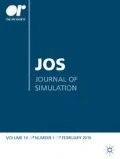Abstract
The objective of this paper is to demonstrate how calculations of greenhouse gas emissions from transport in logistics systems can be analysed with Discrete Event Simulation models. For this, modelling was performed by considering the discrete aspects associated with transport systems with the continuous component of the carbon monoxide emissions from the fleet. The simulation models were constructed with the free and open-source software Ururau. The simulations searched to compare trade-offs of economic and environmental variables, in contrast to what is usually done in these types of systems, such as comparing economic variables with inventory variables. The results indicated that there is no direct relationship of proportionality between, for example, the delivery time and the total emissions produced by trucks.


















Similar content being viewed by others
References
Ballou RH (2004). Business Logistics/Supply Chain Management. 5th edn, Prentice Hall: New Jersey.
Banks J, Carson II JS, Nelson BL and Nicol D (2010). Discrete-Event System Simulation. 5th edn, Prentice-Hall: Englewood Cliffs, NJ.
Brasil DF (2011). Program Control of Air Pollution by Motor Vehicles. PROCONVE, Ministry of the Environment: Brasília, BR.
Byrne PJ, Heavey C, Ryan P and Liston P (2010). Sustainable supply chain design: Capturing dynamic input factors. Journal of Simulation 4 (4): 213–221.
Dettmann T, Andersson C, Andersson J, Skoogh A, Johansson B and Forsbom P (2013). Startup methodology for production flow simulation projects assessing environmental sustainability. In: Pasupathy R, Kim S-H, Tolk A, Hill R and Kuhl ME (eds). Proceedings of the Winter Simulation Conference. Washington DC, USA, pp 1926–1937.
Graham LA, Rideout G, Rosenblatt D and Hendren J (2008). Greenhouse gas emissions from heavy-duty vehicles. Atmospheric Environment 42 (19): 4665–4681.
King DH and Harrison HS (2013). Open-Source Simulation Software ‘JAAMSIM’. In: Pasupathy R, Kim S-H, Tolk A, Hill R and Kuhl ME (eds). Proceedings of the Winter Simulation Conference. Washington DC, USA, pp. 2163–2171.
Kloess M and Müller A (2011). Simulating the impact of policy, energy prices and technological progress on the passenger car fleet in Austria — A model based analysis 2010–2050. Energy Policy 39 (9): 5045–5062.
Manicom B, Green C and Goetz W (1993). Methyl Soyate Evaluation of Various Diesel Blends in a DDC 6v-92 TA Engine. Ortech International: Mississauga, Ontario.
Mercedes Benz (2013). Technical information, http://www.mercedes-benz.com.br, accessed 25 May 2013.
Montevechi JAB, Leal A, Pinho A, Costa RF, Oliveira ML and Silva AL (2010). Conceptual modeling in simulation projects by mean adapted IDEF: An application in a Brazilian company. In: Johansson B, Jain S, Montoya-Torres J, Hugan J and Yücesan E (eds). Proceedings of the Winter Simulation Conference, Baltimore, MD, pp 1624–1635.
Rangel JJA, Oliveira GL, Peixoto TA, Cardoso LD, Matias IO and Shimoda E (2013). Simulation model in a free and open-source software for carbon monoxide emissions analysis. In: Pasupathy R, Kim S-H, Tolk A, Hill R and Kuhl ME (eds). Proceedings of the Winter Simulation Conference. Washington DC, USA, pp 1905–1916.
Rosseti MD (2008). Java simulation library (JSL): An open-source object-oriented library for discrete-event simulation in Java. International Journal of Simulation and Process Modelling 4 (1): 69–87.
Sargent RG (2013). Verifications and validation of simulations models. Journal of Simulation 7 (1): 12–24.
Scania (2013). Technical information, http://www.scania.com.br, accessed 25 May 2013.
Zhou X and Kuhl ME (2011). A sustainability toolkit for simulation: Recent developments and future capabilities. In: Jain S, Creasey RR, Himmelspach J, White KP and Fu M (eds). Proceedings of the Winter Simulation Conference, Phoenix, AZ, USA, pp 850–858.
Acknowledgements
The authors thank the National Council for Scientific and Technological Development (CNPq) and the Research Foundation of the State of Rio de Janeiro (FAPERJ) for financial support for this research. They also thank Maria Marta Garcia for her assistance in translating the text into English.
Author information
Authors and Affiliations
Corresponding author
Appendix
Rights and permissions
About this article
Cite this article
de Assis Rangel, J., Cordeiro, A. Free and Open-Source Software for sustainable analysis in logistics systems design. J Simulation 9, 27–42 (2015). https://doi.org/10.1057/jos.2014.17
Received:
Accepted:
Published:
Issue Date:
DOI: https://doi.org/10.1057/jos.2014.17




